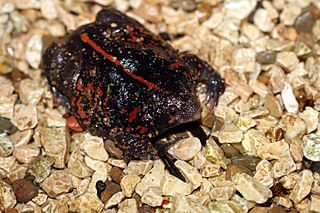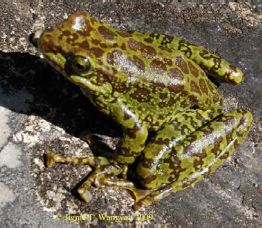
Hylidae is a wide-ranging family of frogs commonly referred to as "tree frogs and their allies". However, the hylids include a diversity of frog species, many of which do not live in trees, but are terrestrial or semiaquatic.

The Mexican burrowing toad is the single living representative of the family Rhinophrynidae. It is a unique species in its taxonomy and morphology, with special adaptations to assist them in digging burrows where they spend most of their time. These adaptations include a small pointed snout and face, keratinized structures and a lack of webbing on front limbs, and specialized tongue morphology to assist in feeding on ants and termites underground. The body is nearly equal in width and length. It is a dark brown to black color with a red-orange stripe on its back along with splotches of color on its body. The generic name Rhinophrynus means 'nose-toad', from rhino- (ῥῑνο-), the combining form of the Ancient Greek rhis and phrunē.

Charadrahyla is a genus of frogs in the family Hylidae. It is endemic to tropical southern Mexico. The generic name was derived from Greek charadra ("ravine") and Hyla, in reference to the habits of these frogs. Accordingly, common name ravine treefrogs has been coined for the genus.
The yellowbelly voiceless tree frog is a species of frog in the family Hylidae endemic to Mexico.

The fairy tree frog is a species of frog in the family Hylidae endemic to Mexico. Its natural habitats are subtropical or tropical moist lowland forests, subtropical or tropical moist montane forests, and rivers. It is threatened by habitat loss.
Charadrahyla nephila is a species of frog in the family Hylidae. It is endemic to Mexico and occurs in the Sierra de Juárez and Sierra Mixe in the northern Oaxacan highlands; there is also a questionable record from the Sierra de los Tuxtlas, Veracruz. Prior to its description, it was mixed with Hyla chaneque. The specific name nephila is derived from Greek nephos ("cloud") and philia ("fondness"), referring to the cloud forest habitat of this species. Common name Oaxacan cloud-forest treefrog has been coined for it.
The spine-fingered tree frog is a species of frog in the family Hylidae endemic to Mexico. Its natural habitat is subtropical or tropical moist montane forests and rivers. It is found in the Sierra Madre del Sur of Guerrero state, on Cerro Teotepec between 1,450 and 2,415 meters elevation, and northwest of Asoleadero. Its extent of occurrence (EOO) is 478 km2.
Charadrahyla pinorum is a species of frog in the family Hylidae. It is endemic to the Pacific slopes of Sierra Madre del Sur between central Guerrero and southwestern and central Oaxaca, Mexico. Common names pine wood treefrog and Mexican pine woods treefrog have been proposed for it. Its closest relative is probably Charadrahyla juanitae.

Amolops mantzorum, commonly known as the Sichuan torrent frog or Kangting sucker frog, is a species of frog in the family Ranidae. It is found in Gansu, Sichuan, and Yunnan Provinces of China. It has recently been reported also from Bhutan.

The spider tortoise is a species of tortoise in the family Testudinidae that is endemic to Madagascar and is one of only two species in the genus Pyxis.
AmphibiaWeb is an American non-profit website that provides information about amphibians. It is run by a group of universities working with the California Academy of Sciences: San Francisco State University, the University of California at Berkeley, University of Florida at Gainesville, and University of Texas at Austin.

Rheohyla is a genus of frogs in the family Hylidae. As currently recognized, it is monotypic, containing only Rheohyla miotympanum, also known as the small-eared hyla or small-eared treefrog. However, the nominal species likely is a complex of more than one species. It is endemic to eastern and central Mexico. The generic name refers to streams, the breeding habitat of this frog. The specific name is derived from Greek meion, a diminutive prefix, together with Greek tympanon (='drum') and refers to the small tympanum.
The Mixteca cloud-forest tree frog is a frog in the family Hylidae. It is endemic to Mexico. Scientists know it exclusively from the type locality: 1390 meters above sea level in the western Sierra Madre del Sur, in Oaxaca.
Charadrahyla esperancensis, the Esperanza tree frog, is a frog in the family Hylidae. It is endemic to Mexico. Scientists have seen it in Oaxaca at 1640 meters above sea level.
Shuanglianpi Wetland is a partially protected natural area in Yilan County in northern Taiwan. Situated 470 meters above sea-level, it contains a botanically rich, shallow lake, which, from the perspective of plant species density, is considered to be a wetland with global significance by the Forestry Bureau of Taiwan.
Sarcohyla toyota, or Toyota's tree frog is a frog in the family Hylidae, endemic to Mexico. Scientists have seen it in cloud forests in the Sierra Madre del Sur mountains between 1975 and 2185 meters above sea level.






